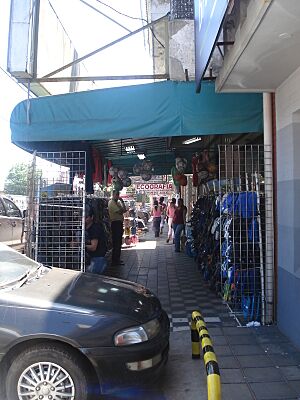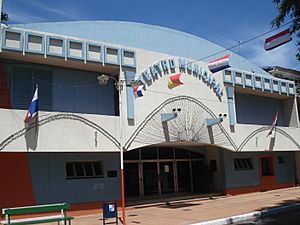Fernando de la Mora, Paraguay facts for kids
Quick facts for kids
Fernando de la Mora
|
||
|---|---|---|
| Fernando de la Mora | ||
 |
||
|
||
| Country | ||
| Department | Central | |
| Founded | February 28, 1939 | |
| Area | ||
| • Total | 21 km2 (8 sq mi) | |
| Elevation | 143 m (469 ft) | |
| Population | ||
| • Total | 183,390 | |
| • Density | 8,730/km2 (22,600/sq mi) | |
| Demonym(s) | Fernandinos | |
| Postal code |
2300
|
|
| Area code(s) | (595)(021) | |
| Climate | Cfa | |
Fernando de la Mora is a lively city in Paraguay. It's part of the big city area around Asunción, the capital. About 183,390 people live here, making it the seventh largest city in the country.
The city is split into two main parts: the South and the North. It covers an area of 21 square kilometers. Many paved streets and avenues cross the city from north to south, like Zavala Cue and Pitiantuta.
Contents
About the City
Fernando de la Mora has 62 green parks where people can relax. It also has a sports center and a football (soccer) field for big games. There are 20 public schools and about 30 private schools.
One of the biggest schools is the Colegio Nacional de EMD Dr. Fernando de la Mora. It has about 3,000 students who attend classes morning, afternoon, or night. This school even has its own sports center! Another important school is the "Dr. Eligio Ayala" School of Infirmary, which teaches students from elementary to advanced levels.
What's in a Name?
The city used to be called Zavala Cue. It was later renamed in honor of Fernando de la Mora. He was one of the important leaders who helped Paraguay become independent from Spain.
Who Lives Here?
Everyone living in Fernando de la Mora lives in urban areas, meaning they live in the city, not the countryside. There are 183,390 people in total. This includes 88,591 men and 94,798 women. The Kamba Cuá neighborhood is home to a special Afro-Paraguayan community.
Weather in Fernando de la Mora
The weather here is usually hot. In summer, temperatures can reach 40 °C (104 °F). In winter, it can get cold, sometimes dropping to 0 °C (32 °F). The average temperature for the whole year is about 22 °C (72 °F).
A Look Back in Time
Fernando de la Mora was once part of a larger district called San Lorenzo del Campo Grande. Back then, it was mostly a farming area known as Zavala Cué. People grew vegetables and fruits and raised farm animals. They supplied food to the city of Asunción.
The name Zavala Cué came from a large estate owned by a family named Zavala. This estate was one of ten big farms in the area.
As more people moved to Zavala Cué, they wanted their own city. The leaders of San Lorenzo didn't seem interested in helping them grow. So, the people of Zavala Cué decided to take action. They worked together to create their own independent city.
Their request was approved by the government on February 28, 1939. Since 1950, Fernando de la Mora has been its own district within the Central Department. Today, it's sometimes called "The city of the new millennia."
City's Economy
Fernando de la Mora has changed a lot from its farming past. Now, it's a busy commercial city. You'll find many small and medium-sized businesses here. These often include companies that work with metals or chemicals.
Many people who live in Fernando de la Mora travel to Asunción for work. This makes it a "dormitory town," meaning people sleep here but often work elsewhere.
Art and Culture
The city has a modern Municipal Theatre right in the center. This theater is a key place for many art events in Paraguay. The city government also helps promote culture by offering art classes.
People in Fernando de la Mora celebrate special religious days. On September 27, they honor the Miraculous Medal. Another important day is January 6, which is Saint Baltazar's Day. The Afro-Paraguayan community celebrates this day.
There's also a historical museum in one of the city's oldest houses, next to the Municipality building. It displays over 1,300 objects and 100 photos from the Paraguayan War and the Chaco War. The museum offers guided tours and special texts for students and visitors.
Places to See
Fernando de la Mora has several interesting places to visit. One is the "6 de Enero" neighborhood. This is where the descendants of the first people of African origin in Paraguay settled. They arrived with Gervasio Artigas. This group, known as the Kamba Cuá, still keeps their traditions alive.
Their dances are very special, with a clear African-American rhythm. These dances are performed at their annual festival on January 6, honoring Saint Baltazar. This celebration is called the "Kamba Cuá" festivity.
Parish Church of the Miraculous Medal
The Parish Church of the Miraculous Medal began its history after the city was founded on July 19, 1942. Many people worked together to build this church. Enrique José Veldman, the first priest, kept the first book of baptisms, which is still saved as a historical treasure.
The first church bell was given by Teodosia Vda. De Gómez. The Florentín Peña family donated images, decorations, and the tabernacle. They brought these items from Buenos Aires, Argentina.
In 1938, a group was formed to build a new, much larger church. Part of the old altar had to be taken down to make space. Architect Anderson Castorino led this work. A small parish school, which is still used today, was also built during the time of Priest Di Perna.
Getting Around
The city is about 8 kilometers (5 miles) from Downtown Asunción. You can get there using Asunción's Avenida Eusebio Ayala (PY02). Other important roads include Avenida Mariscal Lopez (D027) and Avenida Fernando de la Mora (PY01). This last avenue connects Asunción with Fernando de la Mora and other cities like Ypane and Ñemby.
Famous People from Fernando de la Mora
- Fernando Lesme - A football (soccer) player from Paraguay.
- Rafael Lovera - A professional boxer.
- Edgar Rolón - A football (soccer) player from Paraguay.
See also
 In Spanish: Fernando de la Mora (Paraguay) para niños
In Spanish: Fernando de la Mora (Paraguay) para niños






